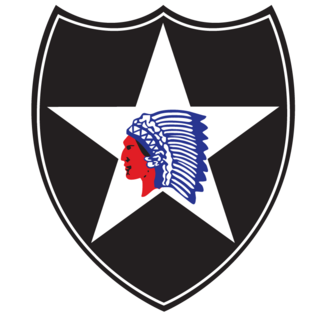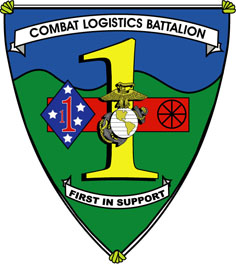
The 2nd Infantry Division ("Indianhead") is a formation of the United States Army. Since the 1960s, its current primary mission is the pre-emptive defense of South Korea in the event of an invasion from North Korea. There are approximately 17,000 soldiers in the 2nd Infantry Division, with 10,000 of them stationed in South Korea, accounting for about 35% of the United States Forces Korea personnel. Denoted the 2nd Infantry Division-ROK/U.S. Combined Division (2ID/RUCD), the division is augmented by rotational Brigade Combat Teams (BCTs) from other U.S. Army divisions.

The Second Battle of Fallujah, initially codenamed Operation Phantom Fury, Operation al-Fajr was an American-led offensive of the Iraq War that lasted roughly six weeks, starting 7 November 2004. Marking the highest point of the conflict against the Iraqi insurgency, it was a joint military effort carried out by the United States, the Iraqi Interim Government, and the United Kingdom. Within the city of Fallujah, the coalition was led by the U.S. Marine Corps and U.S. Army, the battle was later described as "some of the heaviest urban combat Marines have been involved in since Huế City in Vietnam in 1968" and as the toughest battle the U.S. military has been in since the end of the Vietnam War. It was the single bloodiest and fiercest battle of the entire conflict, including for American troops.

Marine Light Attack Helicopter Squadron 367 (HMLA-367) is a United States Marine Corps helicopter squadron consisting of AH-1Z Viper attack helicopters and UH-1Y Venom utility helicopters. Originally commissioned during World War II, the squadron participated in combat operations on Peleliu and Okinawa. Reactivated during the Vietnam War, the squadron has served during numerous conflicts since. The squadron is based at Marine Corps Air Station Camp Pendleton, California and falls under the command of Marine Aircraft Group 39 (MAG-39) and the 3rd Marine Aircraft Wing.

The 5th Marine Regiment is an infantry regiment of the United States Marine Corps based at Marine Corps Base Camp Pendleton, California. It is the most highly decorated regiment in the Marine Corps and falls under the command of the 1st Marine Division and the I Marine Expeditionary Force.

2nd Light Armored Reconnaissance Battalion is a fast and mobilized armored terrestrial reconnaissance battalion of the United States Marine Corps. Their primary weapon system is the 8-wheeled LAV-25 and they fall under the command of the 2nd Marine Division and II Marine Expeditionary Force. The unit is based out of the Marine Corps Base Camp Lejeune, North Carolina. The current mission statement of the battalion is: To perform combined arms reconnaissance and security missions in support of the Ground Combat Element (GCE) of a Marine Air-Ground Task Force (MAGTF). Its mission is to conduct reconnaissance, security and economy of force operations, and, within its capabilities, limited offensive or defensive operations that exploit the unit's mobility and firepower.

The 3d Marine Littoral Regiment is a regiment of the United States Marine Corps that is optimized for littoral maneuver in the Indo-Pacific Theater. Based at Marine Corps Base Hawaii, the regiment falls under the command of the 3rd Marine Division and the III Marine Expeditionary Force. It was known as the 3rd Marine Regiment from 1914 to 2022, when it was renamed as part of the Commandant of the Marine Corps' Force Design 2030 initiative. The 3d MLR has participated in the 2022 and 2023 Balikatan exercises in Northern Luzon, Philippines.
In the United States Marine Corps, a Marine Air–Ground Task Force is the principal organization for all missions across the range of military operations. MAGTFs are a balanced air–ground, combined arms task organization of Marine Corps forces under a single commander that is structured to accomplish a specific mission. The MAGTF was formalized by the publishing of Marine Corps Order 3120.3 in December 1963, "The Marine Corps in the National Defense, MCDP 1-0". It stated:
A Marine air–ground task force with separate air ground headquarters is normally formed for combat operations and training exercises in which substantial combat forces of both Marine aviation and Marine ground units are included in the task organization of participating Marine forces.

5th Battalion, 11th Marines (5/11) was a High Mobility Artillery Rocket System (HIMARS) battalion consisting of four Firing Batteries and a Headquarters Battery. The battalion is stationed at Marine Corps Base Camp Pendleton, California. It is the first active duty HIMARS Unit in the Marine Corps. They fall under the command of the 11th Marine Regiment and the 1st Marine Division. This is the only battalion in the 11th Marine Regiment not using the M777A2 lightweight howitzer.
A regimental combat team (RCT) is a provisional major infantry unit which has seen use by branches of the United States Armed Forces. It is formed by augmenting a regular infantry regiment with smaller combat, combat support and combat service support units.

Combat Logistics Battalion 7(CLB 7) is a logistics battalion of the United States Marine Corps. The unit is based out of the Marine Corps Air Ground Combat Center Twentynine Palms, California and falls under the command of the 1st Marine Logistics Group and I Marine Expeditionary Force.

Combat Logistics Battalion 1 is a logistics battalion of the United States Marine Corps. They are part of Combat Logistics Regiment 1 and the 1st Marine Logistics Group. The unit is based out of the Marine Corps Base Camp Pendleton, California.

Below is an estimated list of the major units deployed within the Multi-National Force – Iraq and other United States military units that were operating in Iraq under the U.S. Central Command (USCENTCOM) in 2009, during the Iraq War.
A Marine expeditionary brigade (MEB) is a formation of the United States Marine Corps, a Marine air-ground task force of approximately 14,500 Marines and sailors constructed around a reinforced infantry regiment, a composite Marine aircraft group, a combat logistics regiment and a MEB command group. The MEB, commanded by a general officer (usually a brigadier general), is task-organized to meet the requirements of a specific situation. It can function as part of a joint task force, as the lead echelon of the Marine expeditionary force (MEF), or alone. It varies in size and composition, and is larger than a Marine expeditionary unit (MEU) but smaller than a MEF. The MEB is capable of conducting missions across the full range of military operations.
This is the Operation Herrick ground order of battle, which lists any British ground forces that have taken part in the duration of Operation Herrick between 2002 and 2014.

Combat Logistics Battalion 6 (CLB-6) is a logistics battalion of the United States Marine Corps. Nicknamed "Red Cloud," the unit is based at Marine Corps Base Camp Lejeune, North Carolina and fall under the command of Combat Logistics Regiment 2 and the 2nd Marine Logistics Group..
In 2009, the United States and NATO International Security Assistance Force (ISAF) coalition, along with Afghan National Army forces, continued military operations against the Taliban in Afghanistan. 2009 marks the eighth year of the War in Afghanistan, which began late in 2001. And 75th ranger regiment is also in Afghanistan as of 2018

Camp Leatherneck was a 1,600 acre United States Marine Corps base in Helmand Province, Afghanistan. The site was mostly in Washir District and was conjoined with Camp Bastion, which was the main British military base in Afghanistan and Camp Shorabak which initially was the main Afghan section however the three sites were joined under the name of 'Camp Shorabak' in 2014.

Operation Strike of the Sword or Operation Khanjar was a US-led offensive in Helmand province in southern Afghanistan. About 4,000 Marines from the 2nd Marine Expeditionary Brigade as well as 650 Afghan troops were involved, supported by NATO planes. The operation began when units moved into the Helmand River valley in the early hours of July 2, 2009. This operation was the largest Marine offensive since the Battle of Fallujah in 2004. The operation was also the biggest offensive airlift by the Marines since the Vietnam War.

Task Force Leatherneck or MEB-Afghanistan was a Marine Air-Ground Task Force that operated in Helmand Province, Afghanistan. The name was originally given to the 2nd Marine Expeditionary Brigade during its 2009-10 operations for OPERATION ENDURING FREEDOM. On July 3, 2010, it was renamed as Regional Command Southwest, RC(SW)|, and in January of 2015 it was renamed Train Advise Assist Command - Southwest (TAAC-SW) under the new NATO mission RESOLUTE SUPPORT. It is also the name used by the 1st Marine Division and 2nd Marine Division during their deployments to Afghanistan. Task Force Leatherneck was commanded by Brigadier General Lawrence D. Nicholson with the command element at Camp Leatherneck. The task force took over the battlespace from Special Purpose MAGTF-Afghanistan on May 29, 2009. In July 2009, Task Force Leatherneck participated in Operation Strike of the Sword, the largest Marine Corps operation since the Battle of Fallujah, and then in February 2010 an even larger battle, the largest of the Afghan Campaign, Operation Moshtarak.
Operation Moshtarak, also known as the Battle of Marjah, was an International Security Assistance Force (ISAF) pacification offensive in the town of Marjah, Helmand Province, Afghanistan. It involved a combined total of 15,000 Afghan, American, British, Canadian, Danish, and Estonian troops, constituting the largest joint operation of the War in Afghanistan up to that point. The purpose of the operation was to remove the Taliban from Marja, thus eliminating the last Taliban stronghold in central Helmand Province. The main target of the offensive was the town of Marjah, which had been controlled for years by the Taliban as well as drug traffickers.
















